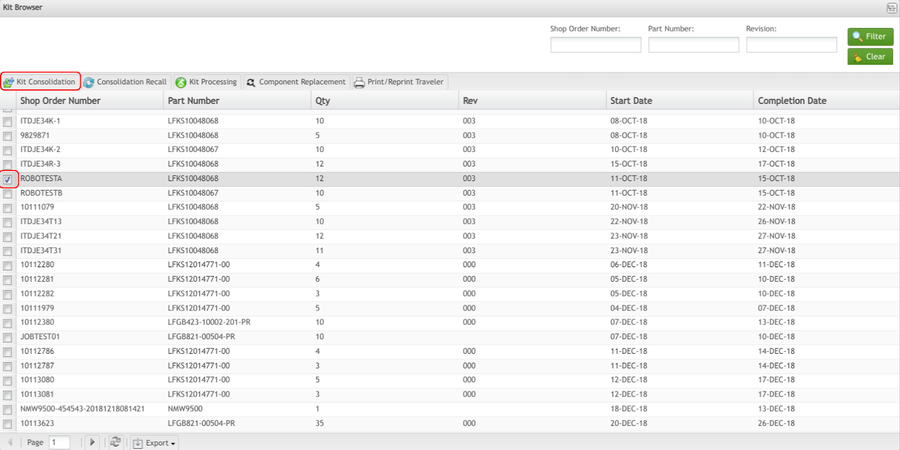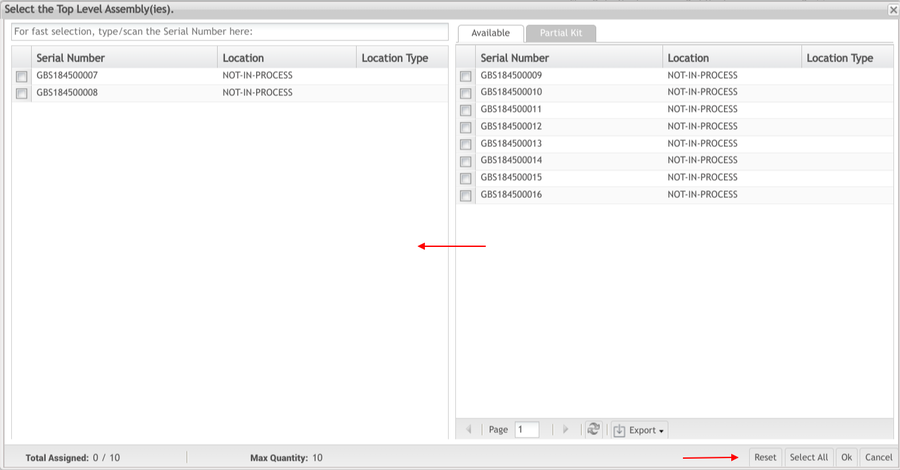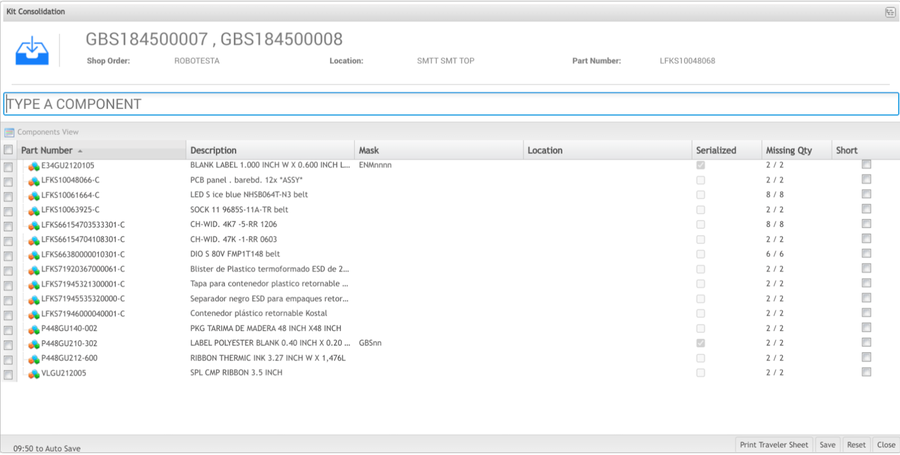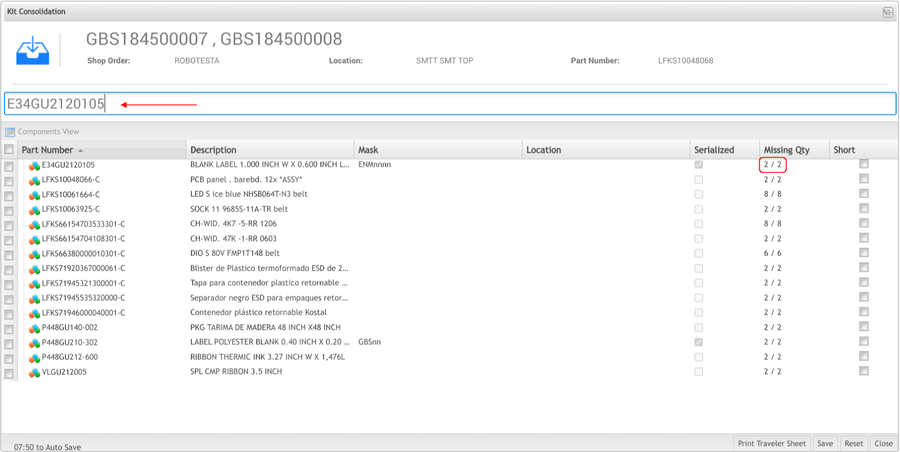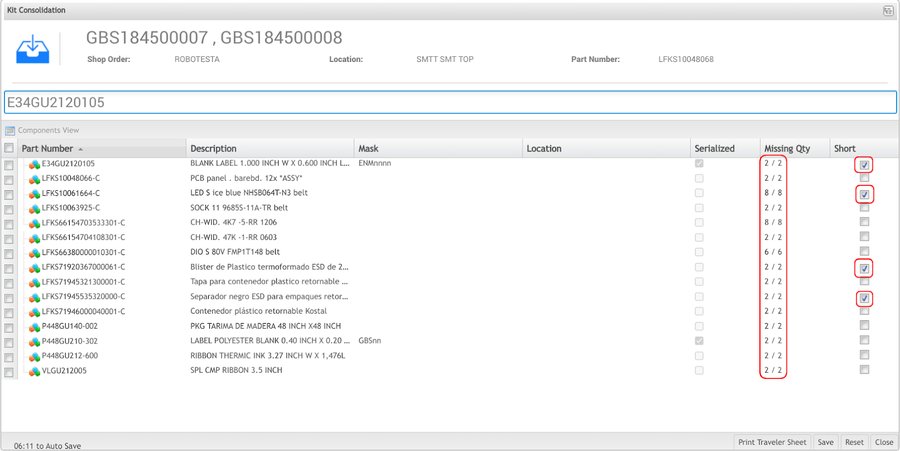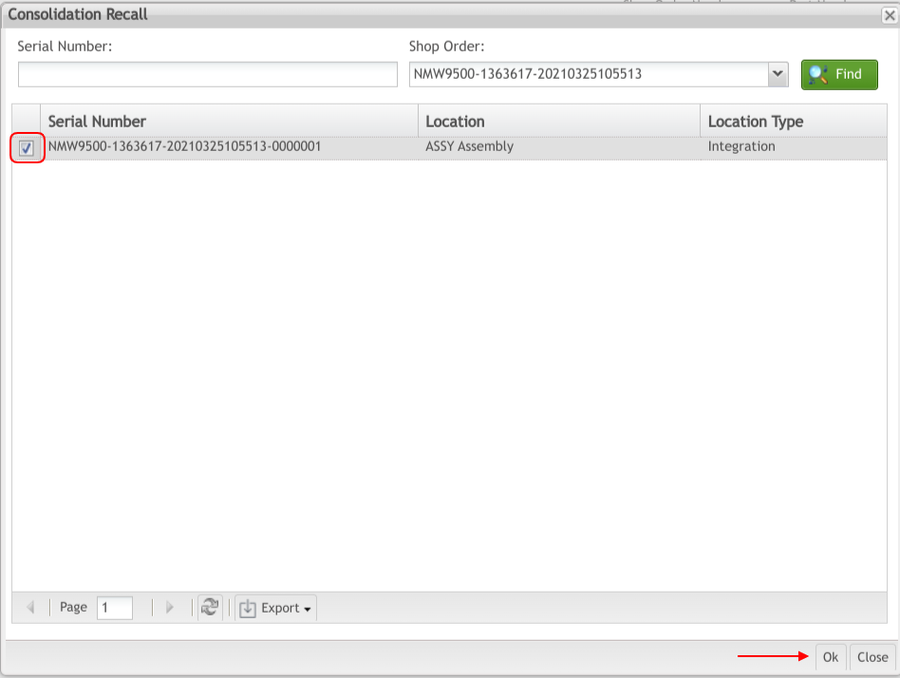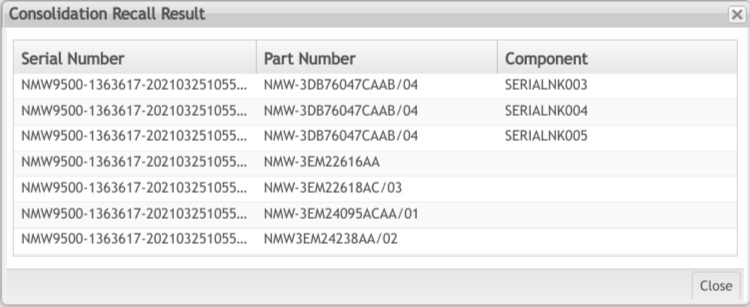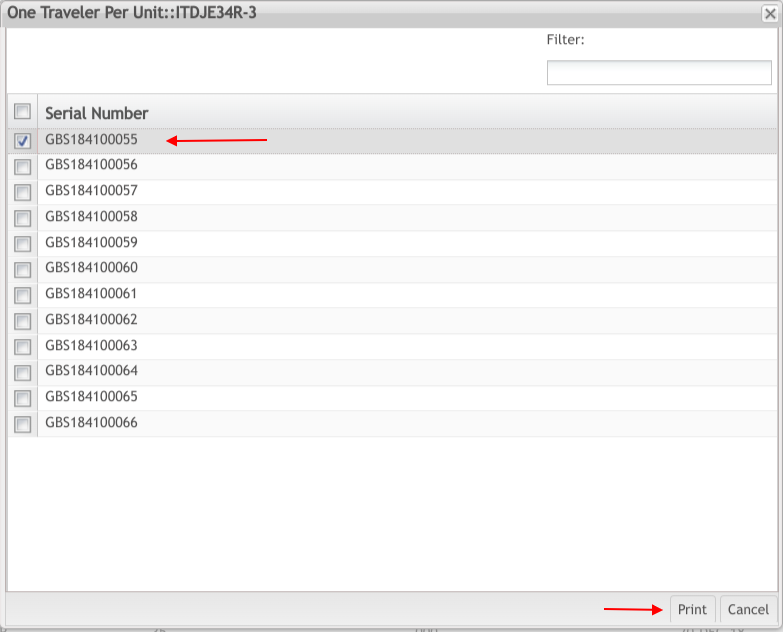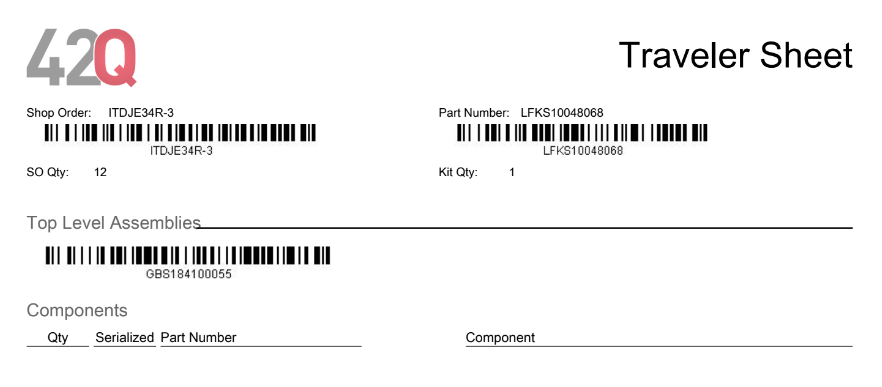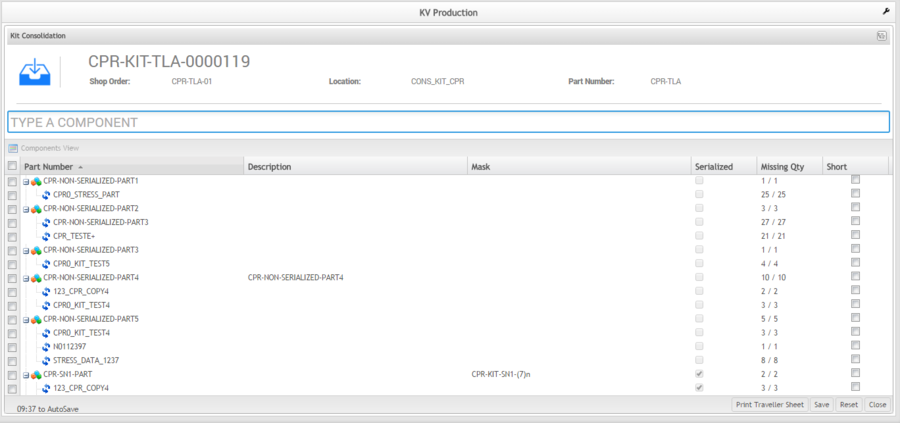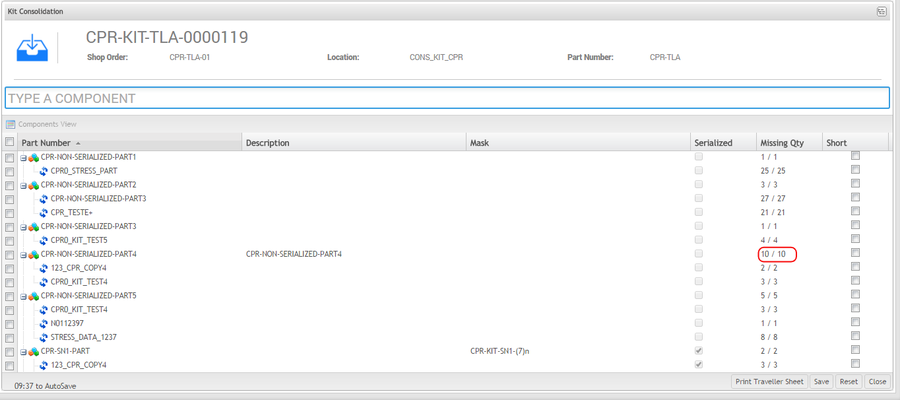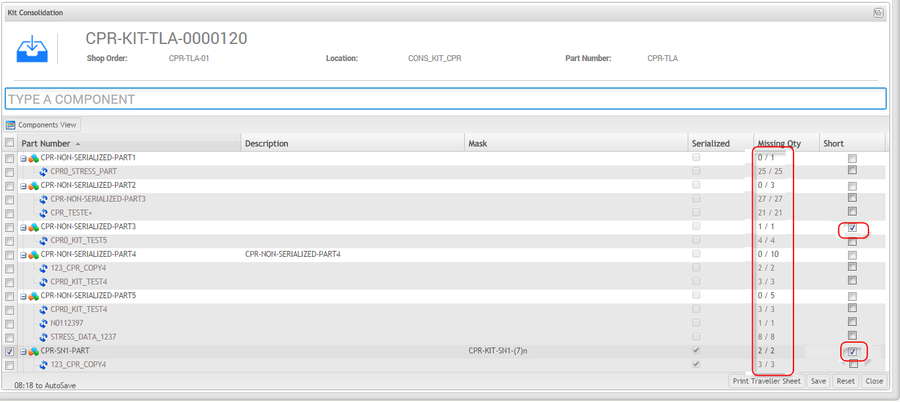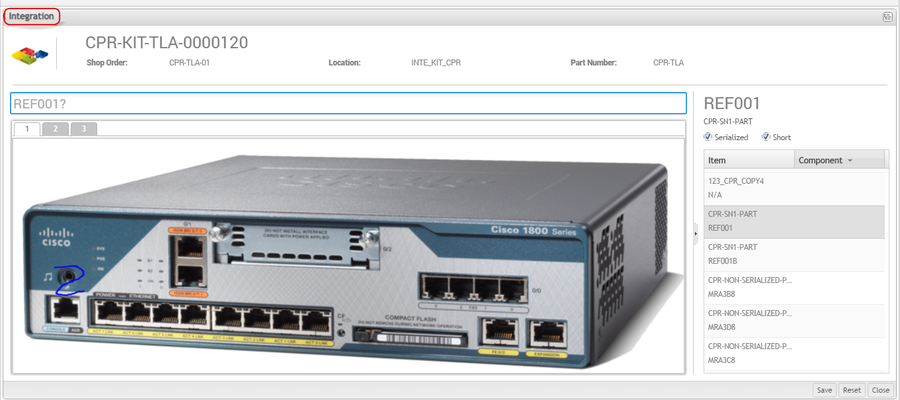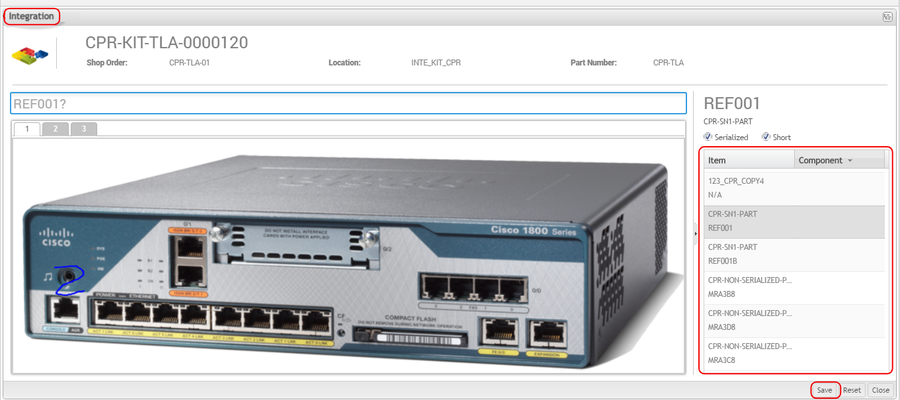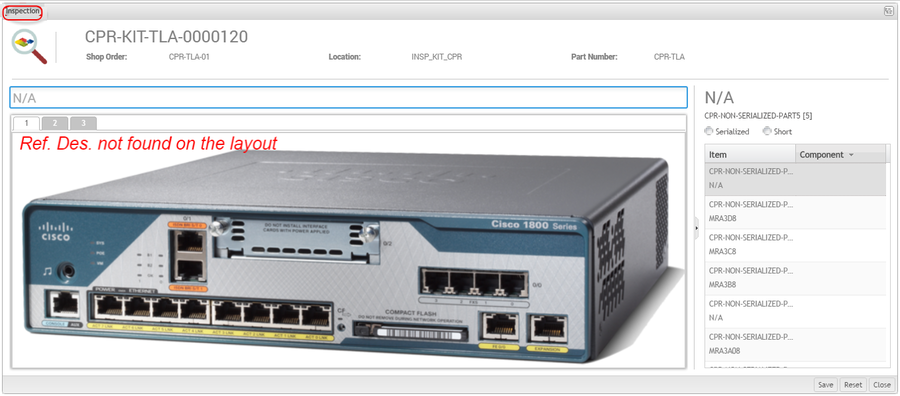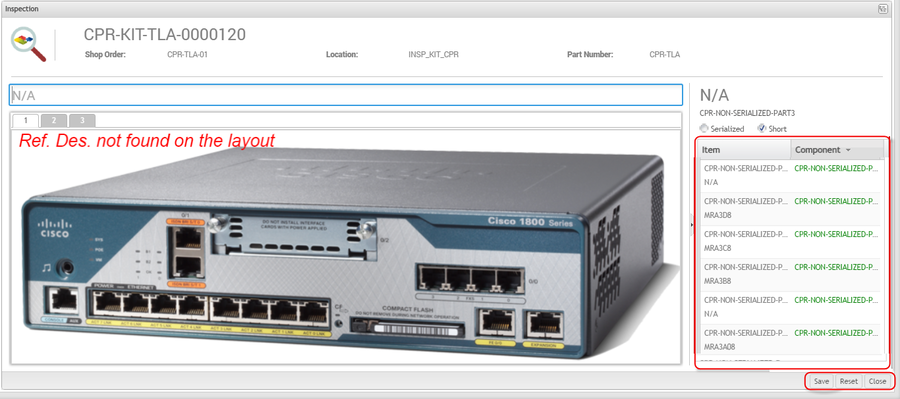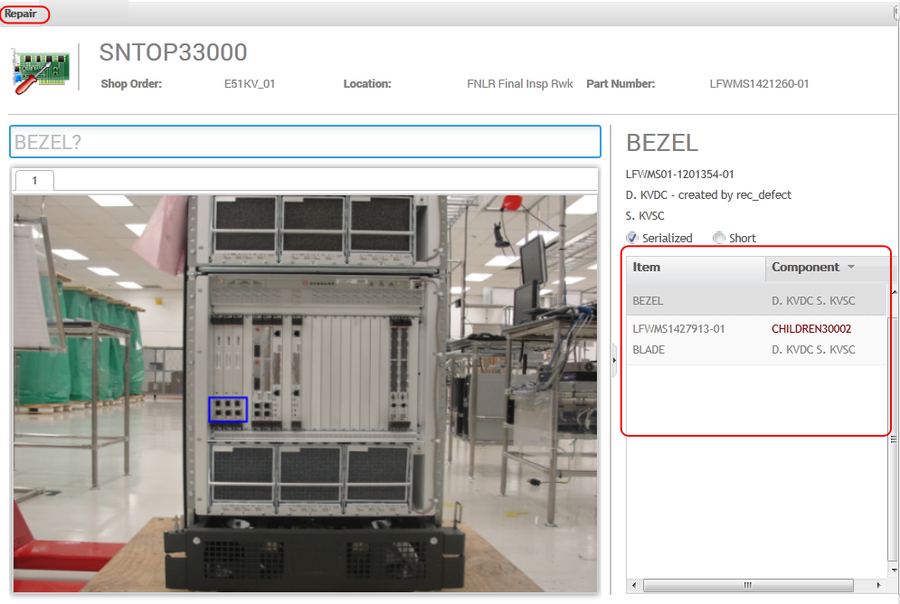Difference between revisions of "SOP-42Q-MES0078 Kit Verify"
(Created page with " <small>42Q Home > Shop Floor Control > Production Control > Kit Verify</small><br/> ...") |
|||
| (2 intermediate revisions by the same user not shown) | |||
| Line 7: | Line 7: | ||
| | ||
| − | <center>'''Shop Floor Control'''</center> <center>''' Production '''</center> <center>'''Kit Verify'''</center> <center>'''Version MES15. | + | <center>'''Shop Floor Control'''</center> <center>''' Production '''</center> <center>'''Kit Verify'''</center> <center>'''Version MES15.82''' </center> |
| − | == Kit Verify | + | |
| + | |||
| + | | ||
| + | |||
| + | | ||
| + | |||
| + | | ||
| + | |||
| + | = <span class="mw-headline" id="Introduction"><span class="mw-headline" id="Introduction"><span class="mw-headline" id="Introduction">Introduction</span></span></span> = | ||
| + | |||
| + | Kit Verify is a tool that consolidates and validates all of the components in a Kit. A kit is provided to the Shop Floor by a warehouse in place of a shop order. Kit Verify allows users to verify that there are no missing components in a kit. | ||
| − | + | Kit Verify assists users in choosing the correct Shop Order that belongs to a certain Serial Number (product), separates Part Numbers that are serialized and that are not serialized (parts or components acquired by vendors), shows the quantity of the components that should be used, adds new Serial Numbers in the MES database, and prints Traveler Reports with the shop orders’ information. It also allows the user to add components to serial numbers attached to Shop Orders, replace components with defects, and modify changes in the database (Repair). | |
| − | + | Kit Verify provides controlled communication integrated into traceability software of products on the shop floor. This allows operational functionality rather than simply providing information configuration and registration. Kit Verify allows the moving of units (orders) of a station for others through commands made available by the application interface. | |
| − | + | Kit Verify consists of the following modules in the MES portal: | |
| − | + | *'''Kit Verify Layout''' - responsible for the mapping of components by reference designators to layouts. | |
| + | *'''Kit Verify''' - responsible for consolidation, integration, inspection, and repair of the kit. | ||
| | ||
| − | + | = <span class="mw-headline" id="Kit_Verify"><span class="mw-headline" id="Kit_Verify"><span class="mw-headline" id="Kit_Verify"><span class="mw-headline" id="Kit_Verify">Kit Verify</span></span></span></span> = | |
| − | + | '''Kit Verify''' allows users to consolidate, integrate, inspect, and repair kits. The Kit Verify module contains two separate portlets, '''Kit Browser''' and '''Kit Processing'''. | |
| − | Kit Browser allows the user to | + | '''Kit Browser''' allows the user to search for the correct Shop Order by Shop Order Number, Part Number, or Revision before performing any task in the Kit Processing portlet. |
| − | + | '''Kit Processing''' allows the user to perform all kitting activities for a Shop Order. | |
| − | |||
| − | |||
| − | + | For Kit Control, there are two customizations available for Genband and NSN customers and this will be explained in the next topics.<br/> | |
| | ||
| − | + | == <span class="mw-headline" id="Kit_Browser"><span class="mw-headline" id="Kit_Browser"><span class="mw-headline" id="Kit_Browser"><span class="mw-headline" id="Kit_Browser">Kit Browser [[File:KV Icon1.png]]</span></span></span></span> == | |
| − | + | Kit Browser allows the user to view and search all available Shop Orders in Kit Verify. This is a convenient way to access Shop Orders without having all of the information that is needed to utilize Kit Processing. | |
| − | | + | To access Kit Browser, navigate to '''Shop Floor Control>Production Control>Kit Verify''', and then select the '''Kit Browser''' icon. |
| | ||
| − | ==== Filter ==== | + | === <span class="mw-headline" id="Filter"><span class="mw-headline" id="Filter"><span class="mw-headline" id="Filter"><span class="mw-headline" id="Filter">Filter</span></span></span></span> === |
Users can filter the Shop Order list by Shop Order Number, Part Number, and/or Revision. Filtering for specific Shop Orders simplifies the process of identifying the correct Shop Order for kitting. | Users can filter the Shop Order list by Shop Order Number, Part Number, and/or Revision. Filtering for specific Shop Orders simplifies the process of identifying the correct Shop Order for kitting. | ||
| Line 50: | Line 59: | ||
| | ||
| − | '''Figure | + | '''Figure 1: Filter Shop Order List''' |
[[File:SCP FilterShopOrderList.png|900px|SCP FilterShopOrderList.png]] | [[File:SCP FilterShopOrderList.png|900px|SCP FilterShopOrderList.png]] | ||
| Line 60: | Line 69: | ||
| | ||
| − | ==== Export ==== | + | === <span class="mw-headline" id="Export"><span class="mw-headline" id="Export"><span class="mw-headline" id="Export"><span class="mw-headline" id="Export">Export</span></span></span></span> === |
The user is able to EXPORT the Shop Order Number List as it is displayed on the page in several formats (.CSV, .HTML, .PDF, .XLS). | The user is able to EXPORT the Shop Order Number List as it is displayed on the page in several formats (.CSV, .HTML, .PDF, .XLS). | ||
| − | '''Figure | + | '''Figure 2: Export Shop Order List''' |
[[File:SCP ExportShopOrderList.png|900px|SCP ExportShopOrderList.png]] | [[File:SCP ExportShopOrderList.png|900px|SCP ExportShopOrderList.png]] | ||
| Line 74: | Line 83: | ||
| | ||
| − | ==== Consolidation ==== | + | === <span class="mw-headline" id="Consolidation"><span class="mw-headline" id="Consolidation"><span class="mw-headline" id="Consolidation"><span class="mw-headline" id="Consolidation">Consolidation</span></span></span></span> === |
The first step in the kitting process is Consolidation. This process consolidates all of the components in a kit. Once a kit is provided to the floor by a warehouse, all of its components must be consolidated to ensure there are no missing units. | The first step in the kitting process is Consolidation. This process consolidates all of the components in a kit. Once a kit is provided to the floor by a warehouse, all of its components must be consolidated to ensure there are no missing units. | ||
| Line 82: | Line 91: | ||
| | ||
| − | '''Figure | + | '''Figure 3: Kit Consolidation''' |
[[File:SCP KitConsolidation.png|900px|SCP KitConsolidation.png]] | [[File:SCP KitConsolidation.png|900px|SCP KitConsolidation.png]] | ||
| Line 94: | Line 103: | ||
| | ||
| − | '''Figure | + | '''Figure 4: Top Level Assemblies''' |
[[File:SCP TopLevelAssemblies.png|900px|SCP TopLevelAssemblies.png]] | [[File:SCP TopLevelAssemblies.png|900px|SCP TopLevelAssemblies.png]] | ||
| Line 106: | Line 115: | ||
| | ||
| − | '''Figure | + | '''Figure 5: Kit Processing- Consolidation''' |
[[File:SCP KitProcessingConsolidation.png|900px|SCP KitProcessingConsolidation.png]] | [[File:SCP KitProcessingConsolidation.png|900px|SCP KitProcessingConsolidation.png]] | ||
| Line 116: | Line 125: | ||
| | ||
| − | '''Figure | + | '''Figure 6: Consolidation''' |
[[File:SCP Consolidation.png|900px|SCP Consolidation.png]] | [[File:SCP Consolidation.png|900px|SCP Consolidation.png]] | ||
| Line 128: | Line 137: | ||
| | ||
| − | '''Figure | + | '''Figure 7: Consolidated with Short Items''' |
[[File:SCP ConsolidatedwithShortItems.png|900px|SCP ConsolidatedwithShortItems.png]] | [[File:SCP ConsolidatedwithShortItems.png|900px|SCP ConsolidatedwithShortItems.png]] | ||
| Line 140: | Line 149: | ||
| | ||
| − | ==== Consolidation Recall | + | === <span class="mw-headline" id="Consolidation_Recall"><span class="mw-headline" id="Consolidation_Recall"><span class="mw-headline" id="Consolidation_Recall"><span class="mw-headline" id="Consolidation_Recall">Consolidation Recall</span></span></span></span> === |
Consolidation Recall removes the consolidation link between a kit's components and its Top-Level serial number. A consolidation recall would be necessary for a Work Order cancellation or a decrease in quantity. | Consolidation Recall removes the consolidation link between a kit's components and its Top-Level serial number. A consolidation recall would be necessary for a Work Order cancellation or a decrease in quantity. | ||
| Line 148: | Line 157: | ||
| | ||
| − | '''Figure | + | '''Figure 8: Consolidation Recall''' |
[[File:SCP ConsolidationRecall.png|900px|SCP ConsolidationRecall.png]] | [[File:SCP ConsolidationRecall.png|900px|SCP ConsolidationRecall.png]] | ||
| Line 158: | Line 167: | ||
| | ||
| − | '''Figure | + | '''Figure 9: Top Level Serial''' |
[[File:SCP TopLevelSerial.png|900px|SCP TopLevelSerial.png]] | [[File:SCP TopLevelSerial.png|900px|SCP TopLevelSerial.png]] | ||
| Line 168: | Line 177: | ||
| | ||
| − | '''Figure | + | '''Figure 10: Consolidation Recall Result''' |
[[File:SCP ConsolidationRecallResult.png|900px|SCP ConsolidationRecallResult.png]] | [[File:SCP ConsolidationRecallResult.png|900px|SCP ConsolidationRecallResult.png]] | ||
| Line 176: | Line 185: | ||
| | ||
| − | ==== Print/Reprint Traveler | + | === <span class="mw-headline" id="Print.2FReprint_Traveler"><span class="mw-headline" id="Print.2FReprint_Traveler"><span class="mw-headline" id="Print.2FReprint_Traveler"><span class="mw-headline" id="Print.2FReprint_Traveler">Print/Reprint Traveler</span></span></span></span> === |
A traveler sheet provides a historical record of the items in a kit. The Shop Order, Part Number, quantity, Top Level Assembly, and all components are provided by the traveler. | A traveler sheet provides a historical record of the items in a kit. The Shop Order, Part Number, quantity, Top Level Assembly, and all components are provided by the traveler. | ||
| Line 184: | Line 193: | ||
| | ||
| − | '''Figure | + | '''Figure 11: Print/Reprint Traveler''' |
[[File:SCP PrintorReprintTraveler.png|900px|SCP PrintorReprintTraveler.png]] | [[File:SCP PrintorReprintTraveler.png|900px|SCP PrintorReprintTraveler.png]] | ||
| Line 192: | Line 201: | ||
| | ||
| − | '''Figure | + | '''Figure 12: Top Level Assembly''' |
[[File:SCP externalprogram.png|900px|SCP externalprogram.png]] | [[File:SCP externalprogram.png|900px|SCP externalprogram.png]] | ||
| Line 204: | Line 213: | ||
| | ||
| − | '''Figure | + | '''Figure 13: Traveler Sheet''' |
[[File:SCP TravelerSheet.png|900px|SCP TravelerSheet.png]] | [[File:SCP TravelerSheet.png|900px|SCP TravelerSheet.png]] | ||
| Line 210: | Line 219: | ||
| | ||
| − | === Kit Processing | + | == <span class="mw-headline" id="Kit_Processing"><span class="mw-headline" id="Kit_Processing"><span class="mw-headline" id="Kit_Processing"><span class="mw-headline" id="Kit_Processing">Kit Processing [[File:KV KitProcess icon2.png]]</span></span></span></span> == |
Kit Processing allows the user to perform Consolidation, Integration, Inspection, and Repair without having to navigate to the Kit Browser portlet to search for the correct Shop Order. If the Top Level Assembly is available for the Shop Order, it can be entered into the Serial Number field. The kit will display in the proper step in the kitting process and the user can complete the kit from the Kit Processing portlet. | Kit Processing allows the user to perform Consolidation, Integration, Inspection, and Repair without having to navigate to the Kit Browser portlet to search for the correct Shop Order. If the Top Level Assembly is available for the Shop Order, it can be entered into the Serial Number field. The kit will display in the proper step in the kitting process and the user can complete the kit from the Kit Processing portlet. | ||
| Line 216: | Line 225: | ||
| | ||
| − | ==== Consolidation | + | === <span class="mw-headline" id="Consolidation_2"><span class="mw-headline" id="Consolidation_2"><span class="mw-headline" id="Consolidation_2"><span class="mw-headline" id="Consolidation_2">Consolidation</span></span></span></span> === |
The first step in the kitting process is Consolidation. This process consolidates all of the components in a kit. Once a kit is provided to the floor by a warehouse, all of its components must be consolidated to ensure there are no missing units. | The first step in the kitting process is Consolidation. This process consolidates all of the components in a kit. Once a kit is provided to the floor by a warehouse, all of its components must be consolidated to ensure there are no missing units. | ||
| Line 230: | Line 239: | ||
| | ||
| − | '''Figure | + | '''Figure 14: Kit Processing- Consolidation''' |
[[File:SCP KPConsolidation.png|900px|SCP KPConsolidation.png]] | [[File:SCP KPConsolidation.png|900px|SCP KPConsolidation.png]] | ||
| Line 240: | Line 249: | ||
| | ||
| − | '''Figure | + | '''Figure 15: Consolidated''' |
[[File:SCP Consolidated.png|900px|SCP Consolidated.png]] | [[File:SCP Consolidated.png|900px|SCP Consolidated.png]] | ||
| Line 252: | Line 261: | ||
| | ||
| − | '''Figure | + | '''Figure 16: Consolidated with Short Items''' |
[[File:SCP ConsolidatedwithShortItems2.png|900px|SCP ConsolidatedwithShortItems2.png]] | [[File:SCP ConsolidatedwithShortItems2.png|900px|SCP ConsolidatedwithShortItems2.png]] | ||
| Line 266: | Line 275: | ||
| | ||
| − | ==== Integration ==== | + | === <span class="mw-headline" id="Integration"><span class="mw-headline" id="Integration"><span class="mw-headline" id="Integration"><span class="mw-headline" id="Integration">Integration</span></span></span></span> === |
The second step in the kitting process is Integration. Integration is responsible for the assembly of the previously consolidated components. | The second step in the kitting process is Integration. Integration is responsible for the assembly of the previously consolidated components. | ||
| Line 276: | Line 285: | ||
| | ||
| − | '''Figure | + | '''Figure 17: Integration''' |
[[File:SCP Integration.png|900px|SCP Integration.png]] | [[File:SCP Integration.png|900px|SCP Integration.png]] | ||
| Line 288: | Line 297: | ||
| | ||
| − | '''Figure | + | '''Figure 18: Integrated Kit''' |
[[File:SCP IntegratedKit.png|900px|SCP IntegratedKit.png]] | [[File:SCP IntegratedKit.png|900px|SCP IntegratedKit.png]] | ||
| Line 298: | Line 307: | ||
| | ||
| − | + | === <span class="mw-headline" id="Inspection"><span class="mw-headline" id="Inspection"><span class="mw-headline" id="Inspection"><span class="mw-headline" id="Inspection">Inspection</span></span></span></span> === | |
| − | |||
| − | ==== Inspection ==== | ||
The third step in the kitting process is Inspection. This step verifies that all previously integrated components are in the correct physical location. | The third step in the kitting process is Inspection. This step verifies that all previously integrated components are in the correct physical location. | ||
| Line 306: | Line 313: | ||
1. To inspect a kit, enter the Top Level Assembly into the field provided | 1. To inspect a kit, enter the Top Level Assembly into the field provided | ||
| − | 2. The '''Kit Processing '''portlet | + | 2. The '''Kit Processing '''portlet is displayed in the '''Inspection '''step. |
| | ||
| − | '''Figure | + | '''Figure 19: Inspection''' |
[[File:SCP Inspection.png|900px|SCP Inspection.png]] | [[File:SCP Inspection.png|900px|SCP Inspection.png]] | ||
| Line 322: | Line 329: | ||
| | ||
| − | '''Figure | + | '''Figure 20: Inspected Kit''' |
[[File:SCP InspectedKit.png|900px|SCP InspectedKit.png]] | [[File:SCP InspectedKit.png|900px|SCP InspectedKit.png]] | ||
| Line 336: | Line 343: | ||
| | ||
| − | ==== Repair ==== | + | === <span class="mw-headline" id="Repair"><span class="mw-headline" id="Repair"><span class="mw-headline" id="Repair"><span class="mw-headline" id="Repair">Repair</span></span></span></span> === |
The fourth step in the kitting process is Repair. Repair allows for the repairing or replacing of failed components in the kit. | The fourth step in the kitting process is Repair. Repair allows for the repairing or replacing of failed components in the kit. | ||
| Line 344: | Line 351: | ||
2. The '''Kit Processing '''portlet displays in the '''Repair '''step. | 2. The '''Kit Processing '''portlet displays in the '''Repair '''step. | ||
| − | 3. Only the components that have failed during the inspection step will | + | 3. Only the components that have failed during the inspection step will be displayed in the repair step. |
| | ||
| − | '''Figure | + | '''Figure 21: Repair''' |
[[File:SCP repair.png|900px|SCP repair.png]] | [[File:SCP repair.png|900px|SCP repair.png]] | ||
| Line 358: | Line 365: | ||
6. Complete the Inspection step again after repairing the failed items. | 6. Complete the Inspection step again after repairing the failed items. | ||
| − | 7. Once all items have been successfully inspected, the kit is complete and will no longer | + | 7. Once all items have been successfully inspected, the kit is complete and will no longer be displayed in the '''Kit Processing '''portlet. |
| − | |||
| − | |||
| − | |||
| − | |||
| − | |||
| − | |||
| − | |||
| − | |||
| − | |||
| − | |||
| − | |||
| − | |||
| − | |||
| − | |||
| − | |||
| − | |||
| − | |||
| − | |||
| − | |||
| − | |||
| − | |||
| − | |||
| − | |||
| − | |||
| − | |||
| − | |||
| − | |||
| − | |||
| − | |||
| − | |||
| − | |||
| − | |||
| − | |||
| − | |||
| − | |||
| − | |||
| − | |||
| − | |||
| − | |||
| − | |||
| − | |||
| − | |||
| − | |||
| − | |||
| − | |||
| − | |||
| − | |||
| − | |||
| − | |||
| − | |||
| − | |||
| − | |||
| − | |||
| − | |||
| − | |||
| − | |||
| − | |||
| − | |||
| − | |||
| − | |||
| − | |||
| − | |||
| − | |||
| − | |||
| − | |||
| − | |||
| − | |||
| − | |||
| − | |||
| − | |||
| − | |||
| − | |||
| − | |||
| − | |||
| − | |||
| − | |||
| − | |||
| − | |||
| − | |||
| − | |||
| − | |||
| − | |||
| − | |||
| − | |||
| − | |||
| − | |||
| − | |||
| − | |||
| − | |||
| − | |||
| − | |||
| − | |||
| − | |||
| − | |||
| | ||
| − | + | ---- | |
| | ||
| − | |||
| − | |||
| − | |||
| − | |||
| − | |||
| − | |||
| − | |||
| − | |||
| − | |||
| − | |||
| − | |||
| − | |||
| − | |||
| − | |||
| − | |||
| − | |||
| − | |||
| − | |||
| − | |||
| − | |||
| − | |||
| − | |||
| − | |||
| − | |||
| − | |||
| − | |||
| − | |||
| − | |||
| − | |||
| − | |||
| − | |||
| − | |||
| − | |||
| − | |||
| − | |||
| − | |||
| − | |||
| − | |||
| − | |||
| − | |||
| − | |||
| − | |||
| − | |||
| − | |||
| − | |||
| − | |||
| − | |||
| − | |||
| − | |||
| − | |||
| − | |||
| − | |||
| − | |||
| − | |||
| − | |||
| − | |||
| − | |||
| − | |||
| − | |||
| − | |||
| − | |||
| − | |||
| − | |||
| − | |||
| − | |||
| − | |||
| − | |||
| − | |||
| − | |||
| − | |||
| − | |||
| − | |||
| − | |||
| − | |||
| − | |||
| − | |||
| − | |||
Latest revision as of 22:31, 14 October 2024
42Q Home > Shop Floor Control > Production Control > Kit Verify
Contents
Introduction
Kit Verify is a tool that consolidates and validates all of the components in a Kit. A kit is provided to the Shop Floor by a warehouse in place of a shop order. Kit Verify allows users to verify that there are no missing components in a kit.
Kit Verify assists users in choosing the correct Shop Order that belongs to a certain Serial Number (product), separates Part Numbers that are serialized and that are not serialized (parts or components acquired by vendors), shows the quantity of the components that should be used, adds new Serial Numbers in the MES database, and prints Traveler Reports with the shop orders’ information. It also allows the user to add components to serial numbers attached to Shop Orders, replace components with defects, and modify changes in the database (Repair).
Kit Verify provides controlled communication integrated into traceability software of products on the shop floor. This allows operational functionality rather than simply providing information configuration and registration. Kit Verify allows the moving of units (orders) of a station for others through commands made available by the application interface.
Kit Verify consists of the following modules in the MES portal:
- Kit Verify Layout - responsible for the mapping of components by reference designators to layouts.
- Kit Verify - responsible for consolidation, integration, inspection, and repair of the kit.
Kit Verify
Kit Verify allows users to consolidate, integrate, inspect, and repair kits. The Kit Verify module contains two separate portlets, Kit Browser and Kit Processing.
Kit Browser allows the user to search for the correct Shop Order by Shop Order Number, Part Number, or Revision before performing any task in the Kit Processing portlet.
Kit Processing allows the user to perform all kitting activities for a Shop Order.
For Kit Control, there are two customizations available for Genband and NSN customers and this will be explained in the next topics.
Kit Browser 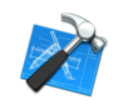
Kit Browser allows the user to view and search all available Shop Orders in Kit Verify. This is a convenient way to access Shop Orders without having all of the information that is needed to utilize Kit Processing.
To access Kit Browser, navigate to Shop Floor Control>Production Control>Kit Verify, and then select the Kit Browser icon.
Filter
Users can filter the Shop Order list by Shop Order Number, Part Number, and/or Revision. Filtering for specific Shop Orders simplifies the process of identifying the correct Shop Order for kitting.
To filter the Shop Order list, enter a Shop Order Number, Part Number, and/or a Revision into the filter fields provided and then select Filter.
Figure 1: Filter Shop Order List
Note: To begin a new search, select Clear to empty the fields and re-enter information into the available fields.
Export
The user is able to EXPORT the Shop Order Number List as it is displayed on the page in several formats (.CSV, .HTML, .PDF, .XLS).
Figure 2: Export Shop Order List
To Export the Shop Order Number List, select the file type (.CSV, .HTML, .PDF, .XLS), the page orientation (portrait or landscape), and the fields to be displayed in the file to be exported by double clicking on the field or selecting the green arrows. Click on Export to save the file.
Consolidation
The first step in the kitting process is Consolidation. This process consolidates all of the components in a kit. Once a kit is provided to the floor by a warehouse, all of its components must be consolidated to ensure there are no missing units.
1. To consolidate a kit from Kit Browser, select the Shop Order from the list and then select Kit Consolidation.
Figure 3: Kit Consolidation
2. The Select the Top-level Assembly(ies) form displays. All available serials are listed in the right column. The user can enter the serial into the field provided, or select the serial from the available column by double-clicking on it.
3. Once the serial is in the left column, select the Serial Number and then select OK to open the Kit Processing portlet.
Figure 4: Top Level Assemblies
4. The Kit Processing portlet displays in the Kit Consolidation step.
5. All associated Part Numbers are listed for consolidation.
Figure 5: Kit Processing- Consolidation
6. To consolidate the components, select each part number and then enter or scan the Part Number (for Non-Serialized components) or the serial that fits the mask (for Serialized components).
Figure 6: Consolidation
7. This process zeros out the Missing Quantity, thus consolidating all the components in the kit.
8. If there are missing components, mark the item as short by selecting the Short checkbox in the far right column.
Figure 7: Consolidated with Short Items
9. After consolidating all of the components, select Save to confirm.
10. Select Close to return to the Kit Browser main page.
Consolidation Recall
Consolidation Recall removes the consolidation link between a kit's components and its Top-Level serial number. A consolidation recall would be necessary for a Work Order cancellation or a decrease in quantity.
1. To perform a consolidation recall in the Kit Browser portlet, select a Shop Order from the list that has been consolidated and then select Consolidation Recall.
Figure 8: Consolidation Recall
2. The Consolidation Recall form displays. Select a Top Level serial and then select OK.
Figure 9: Top Level Serial
3. A confirmation pop-up displays. Select Yes to continue.
4. The Consolidation Recall Result pop-up displays the Serial Number, Part Number, and Component information that has been recalled.
Figure 10: Consolidation Recall Result
Print/Reprint Traveler
A traveler sheet provides a historical record of the items in a kit. The Shop Order, Part Number, quantity, Top Level Assembly, and all components are provided by the traveler.
1. To print a traveler, select the Shop Order from the Shop Order Number list and then select Print/Reprint Traveler.
Figure 11: Print/Reprint Traveler
2. The One Traveler Per Unit:: form displays. Select the Top Level Assembly serial number and then select Print.
Figure 12: Top Level Assembly
3. The traveler will be prompted to be opened with an external program. Select the program with which to open the file and then select OK.
4. The traveler will open the external program for the user to print.
Figure 13: Traveler Sheet
Kit Processing 
Kit Processing allows the user to perform Consolidation, Integration, Inspection, and Repair without having to navigate to the Kit Browser portlet to search for the correct Shop Order. If the Top Level Assembly is available for the Shop Order, it can be entered into the Serial Number field. The kit will display in the proper step in the kitting process and the user can complete the kit from the Kit Processing portlet.
Consolidation
The first step in the kitting process is Consolidation. This process consolidates all of the components in a kit. Once a kit is provided to the floor by a warehouse, all of its components must be consolidated to ensure there are no missing units.
Note: Best Practice- Before Consolidation, the Assembly Tables for all Serialized Components must be configured with Part Number masks.
1. To consolidate a kit, enter the Top Level Assembly into the field provided.
2. The Kit Processing portlet displays in the Kit Consolidation step.
3. All associated Part Numbers are listed for consolidation.
Figure 14: Kit Processing- Consolidation
4. To consolidate the components, select each part number and then enter or scan the Part Number (for Non-Serialized components) or the serial that fits the mask (for Serialized components).
Figure 15: Consolidated
5. This process zeros out the Missing Quantity, thus consolidating all the components in the kit.
6. If there are missing components, mark the item as short by selecting the Short checkbox in the far right column.
Figure 16: Consolidated with Short Items
7. After consolidating all of the components, select Save to confirm.
8. "The record has been successfully saved" displays.
Integration
The second step in the kitting process is Integration. Integration is responsible for the assembly of the previously consolidated components.
1. To integrate a kit, enter the Top Level Assembly into the field provided
2. The Kit Processing portlet displays in the Integration step.
Figure 17: Integration
3. To integrate the components, select each item in the Item list and scan/enter the previously consolidated part number for non-serialized components or the serial that complies with the mask for serialized components.
Note: For non-serialized components with reference designators, the user will have to enter/scan the part number as many times as there are reference designators.
4. For short items, enter a serial that complies with the mask to integrate the component.
Figure 18: Integrated Kit
5. Once all items have been integrated, select Save to confirm.
6. The record has been successfully saved" displays.
Inspection
The third step in the kitting process is Inspection. This step verifies that all previously integrated components are in the correct physical location.
1. To inspect a kit, enter the Top Level Assembly into the field provided
2. The Kit Processing portlet is displayed in the Inspection step.
Figure 19: Inspection
3. To inspect the components, select each item in the Item list and scan/enter the previously consolidated part number for non-serialized components or the serial that complies with the mask for serialized components.
Note: For non-serialized components with reference designators, the user will have to enter/scan the part number as many times as there are reference designators.
Figure 20: Inspected Kit
4. Once all items have been inspected, select Save to confirm.
5. "The record has been successfully saved" displays.
Note: If there are failed components in a kit, they will display in red when entered/scanned and the kit will be sent to Repair when saved.
Repair
The fourth step in the kitting process is Repair. Repair allows for the repairing or replacing of failed components in the kit.
1. To repair a kit, enter the Top Level Assembly into the field provided
2. The Kit Processing portlet displays in the Repair step.
3. Only the components that have failed during the inspection step will be displayed in the repair step.
Figure 21: Repair
4. To repair the components, select each item in the Item list and scan/enter the correct serial or part number that is displayed in the Component list.
5. Once all items have been repaired, select Save to confirm. This sends the kit back to the inspection step.
6. Complete the Inspection step again after repairing the failed items.
7. Once all items have been successfully inspected, the kit is complete and will no longer be displayed in the Kit Processing portlet.


